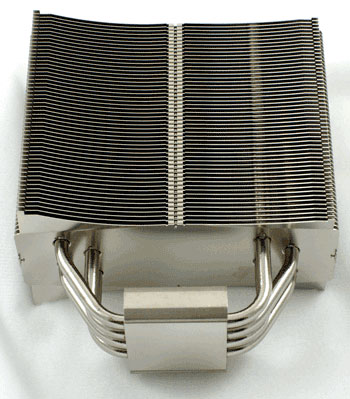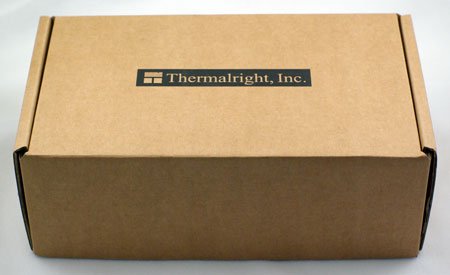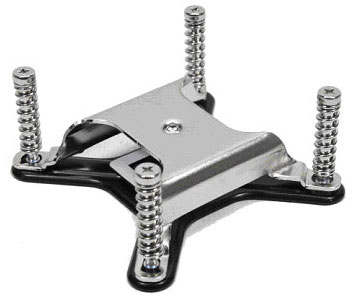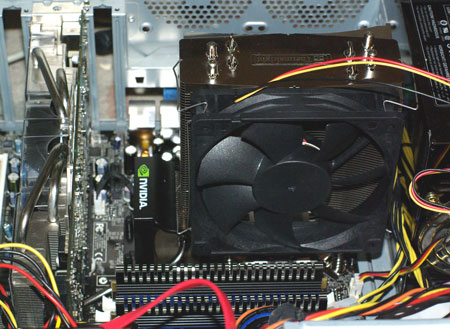Thermalright Ultra 120: Elegant, Fanless and Efficient Cooling
by Wesley Fink on March 5, 2007 12:05 AM EST- Posted in
- Cases/Cooling/PSUs
Thermalright Ultra 120
Thermalright specializes in the enthusiast market, manufacturing the usual CPU coolers but also chipset, VGA, and RAM coolers, as well as thermal paste. Thermalright emphasizes their design capabilities in the cooling market, and their advanced manufacturing processes are ISO-9000 certified.
Most hobbyists first heard of Thermalright when their SK-6 cooler appeared in the summer of 2001 and started winning most of the heatsink roundups. Since then Thermalright has become a well-respected name in high-end air cooling. Thermalright produced several well-known heatsinks for the AMD K8 and Pentium 4 sockets, such as the XP-120 and XP-90 heatsinks. You bought the Thermalright heatsink and paired it with the 120mm or 90mm fan of your choice - for low noise or massive air flow or some combination that met your needs.

The Thermalright Ultra 120 is a top-of-the-line heatsink. As the top model in the current Thermalright lineup it is targeted at enthusiasts who want the best and most flexible performance available in a CPU cooler. The Ultra 120 mounts 120mm fans, but there is also a smaller and lighter version called the Ultra 90 that logically mounts 92mm fans.

The Ultra 120 comes packaged in the usual plain brown Thermalright box. All the Thermalright coolers we have seen are shipped in sturdy natural cardboard boxes. Some would argue the name says it all. Like Godiva in chocolates, Thermalright says you have the best. Whether Thermalright really is the best is what this review will help determine.

Inside the box you will find an exceptionally well-protected Ultra 120 heatsink, along with everything you need to mount the Ultra 120 on an Intel Socket 775 or an AMD Athlon 64/FX/X2/Opteron.

For AM2 you will need to purchase an Ultra-120 AM2 adapter, which sells for about $8. The Ultra 120 is not currently available in an AM2 version right out of the box. The smaller Ultra-90 does come in an AM2 version.
The Thermalright Ultra 120 kit is available for around $47 retail. The Ultra 90 sells for a little less, around $40. You will also need a 120mm fan such as the Scythe S-Flex SFF21F or the Noctua fans. Just keep in mind that the fan needs holes for the fan wires to work - solid post fans will not work. At a total cost for heatsink and fan of around $50 to $60 the Thermalright is competitively priced with other top heatsink towers like the Tuniq Tower 120 and the Scythe Infinity.

The Scythe S-Flex fan that was tested with the Thermalright comes with just a 3-pin connector. It can be powered directly by the board, or if you are concerned about current draw Scythe provides a 4-pin Molex to fan adapter. Since there is no 4-pin connection you will need something like the Zalman Fan Mate controller if you want to vary the fan speed of the S-Flex. On motherboards supported by Speed Fan, that free software utility is also an option for controlling fan speed.

Installing the Ultra 120 is relatively easy, but you will need to remove the motherboard from the case to install. A mounting plate rests on the back of the board with screw pegs passing through the mounting holes on the board. The heavy Ultra 120 is then supported by four spring-loaded screws on a mounting plate that covers the entire top of the CPU mounting block.

Thermalright has developed a very logical method of installation that provides security for the heavy Ultra 120 heatsink. There was never a worry that the Ultra 120 would fall off the board or rip out of the mounting holes. However, caution is still needed in moving a system with the Ultra 120. The heatsink weighs 745g and the fan we used is 180g. That total weight of 925g is just over two pounds.

We had no problems during testing and moving our test tower around. However, constantly moving a tower system with this kind of cooler weight supported by the motherboard could over flex the board and cause failure.
Specifications
Our test system is Intel Socket 775, but the Thermalright Ultra 120 will also mount on any AMD 754/939/940 CPU with the included adapter. An optional AM2 adapter is needed for that socket.
S-Flex fans are available in other noise and air flow specifications to meet your needs. The SFF21D has an 8.7dB-A noise rating at 33.5CFM, while the mid-range 21E is 20.1 dB-A at 49.0 CFM. Noctua also has a wide range of fans that will fit the Ultra 120. You will find a wide selection of fans available at etailers like Newegg or Frozen CPU.
Thermalright specializes in the enthusiast market, manufacturing the usual CPU coolers but also chipset, VGA, and RAM coolers, as well as thermal paste. Thermalright emphasizes their design capabilities in the cooling market, and their advanced manufacturing processes are ISO-9000 certified.
Most hobbyists first heard of Thermalright when their SK-6 cooler appeared in the summer of 2001 and started winning most of the heatsink roundups. Since then Thermalright has become a well-respected name in high-end air cooling. Thermalright produced several well-known heatsinks for the AMD K8 and Pentium 4 sockets, such as the XP-120 and XP-90 heatsinks. You bought the Thermalright heatsink and paired it with the 120mm or 90mm fan of your choice - for low noise or massive air flow or some combination that met your needs.

The Thermalright Ultra 120 is a top-of-the-line heatsink. As the top model in the current Thermalright lineup it is targeted at enthusiasts who want the best and most flexible performance available in a CPU cooler. The Ultra 120 mounts 120mm fans, but there is also a smaller and lighter version called the Ultra 90 that logically mounts 92mm fans.

The Ultra 120 comes packaged in the usual plain brown Thermalright box. All the Thermalright coolers we have seen are shipped in sturdy natural cardboard boxes. Some would argue the name says it all. Like Godiva in chocolates, Thermalright says you have the best. Whether Thermalright really is the best is what this review will help determine.

Inside the box you will find an exceptionally well-protected Ultra 120 heatsink, along with everything you need to mount the Ultra 120 on an Intel Socket 775 or an AMD Athlon 64/FX/X2/Opteron.

For AM2 you will need to purchase an Ultra-120 AM2 adapter, which sells for about $8. The Ultra 120 is not currently available in an AM2 version right out of the box. The smaller Ultra-90 does come in an AM2 version.
The Thermalright Ultra 120 kit is available for around $47 retail. The Ultra 90 sells for a little less, around $40. You will also need a 120mm fan such as the Scythe S-Flex SFF21F or the Noctua fans. Just keep in mind that the fan needs holes for the fan wires to work - solid post fans will not work. At a total cost for heatsink and fan of around $50 to $60 the Thermalright is competitively priced with other top heatsink towers like the Tuniq Tower 120 and the Scythe Infinity.

The Scythe S-Flex fan that was tested with the Thermalright comes with just a 3-pin connector. It can be powered directly by the board, or if you are concerned about current draw Scythe provides a 4-pin Molex to fan adapter. Since there is no 4-pin connection you will need something like the Zalman Fan Mate controller if you want to vary the fan speed of the S-Flex. On motherboards supported by Speed Fan, that free software utility is also an option for controlling fan speed.

Installing the Ultra 120 is relatively easy, but you will need to remove the motherboard from the case to install. A mounting plate rests on the back of the board with screw pegs passing through the mounting holes on the board. The heavy Ultra 120 is then supported by four spring-loaded screws on a mounting plate that covers the entire top of the CPU mounting block.

Thermalright has developed a very logical method of installation that provides security for the heavy Ultra 120 heatsink. There was never a worry that the Ultra 120 would fall off the board or rip out of the mounting holes. However, caution is still needed in moving a system with the Ultra 120. The heatsink weighs 745g and the fan we used is 180g. That total weight of 925g is just over two pounds.

We had no problems during testing and moving our test tower around. However, constantly moving a tower system with this kind of cooler weight supported by the motherboard could over flex the board and cause failure.
Specifications
Our test system is Intel Socket 775, but the Thermalright Ultra 120 will also mount on any AMD 754/939/940 CPU with the included adapter. An optional AM2 adapter is needed for that socket.
| Thermalright Ultra 120 Specifications | |
| Heatsink | |
| Dimensions | 63.5(L) X 132(W) X 160.5(H)mm (excluding fan) |
| Weight | 745g (excluding fan) |
| Material | Nickel-plated Copper and Aluminum |
| Fan Configuration | Supports 120mm fans with open mounting posts |
| Optional Fan | |
| Model | Scythe S-Flex SFF21F |
| Fan Size | 120mm x 120mm x 25mm |
| Bearing Type | Sony Fluid Dynamic Bearing |
| Noise Level | 28.0 dbA |
| Speed | 1600 rpm |
| Air Flow | 63.7 CFM |
| Fan Life | 150,000 hrs (vs. 50,000 hrs for ball bearing) |
| Weight | 180g (fan only) |
S-Flex fans are available in other noise and air flow specifications to meet your needs. The SFF21D has an 8.7dB-A noise rating at 33.5CFM, while the mid-range 21E is 20.1 dB-A at 49.0 CFM. Noctua also has a wide range of fans that will fit the Ultra 120. You will find a wide selection of fans available at etailers like Newegg or Frozen CPU.










30 Comments
View All Comments
Wesley Fink - Monday, March 5, 2007 - link
The Thermalright mounting holes were not designed to hold fan wires for two fans. They are about the diameter of a single wire and two just won't fit. The lower fan clip mount hole opens and breaks if you try to mount two fan wires in the mounting hole. Clearly Thermalright did not design the Ultra 120 for multiple fan mount, though we agree the design looks a natural for a push-pull fan setup. In the end the Thermalright cooled as well or better than anything, even a two-fan Infinity, using just one excellent fan.The mounting surface of the Thermalright was reasonably flat and smooth. The flatness mattered a great deal more when you were dealing with a small surface area mount like the AMD Socket A from the past. With processors today shipping with a large area heatspreader the surface flatness is less important, but it still matters.
The proper application of thermal compound matters a great deal in performance. We usually place a little larger than a BB-sixed glob of thermal in the center of the CPU and mount. When the heatsink is removed that normally has spread on mounting to the edges of the processor with no thermal grease builup around the sides of the processor. THe prurpose of thermal grease is to fill the irregularites of the mounting surfaces and improve contact between the mounting surfaces.
xsilver - Monday, March 5, 2007 - link
would it be easy for a mod job to add the ability to mount 2 fans? screwing them in to the fins directly maybe?JoKeRr - Monday, March 5, 2007 - link
Guess in the end it's not just the # of heatpipes and overall fin surface area. Great review overall. btw, what kind of thermal compound do you guys use? And I thought fluid dynamic bearing was developed by Panasonic instead of sony.Would it be possible in the future to test arctic coolings Freezer 7 Pro? That looks like a decent tower heatsink, and it comes with a fan too. Also it's much cheaper as well. It will be really nice to see how that heatsink compares to the bigger towers. Another question I have concerns with previous generation heatsinks. Currently I have a ThermalRight XP-90 with a 92mm panaflo, my cpu is a socket 478 P4 3.0ghz OCed to 3.6ghz at default v-core (it's a northwood core btw). I know XP-90 is a very good heatsink, and I'm really considering of using it on my future LGA775 setup (with a LGA775 bracket), but it's really hard to compare it with new heatsinks. Thanks again.
Wesley Fink - Monday, March 5, 2007 - link
I have referenced the review showing toothpaste and Kraft Vegemite superior to a well-known siver compound several times in past review comments. As we have stated several times, in our experience the thermal compound doen't matter. The Thermalright comes with a white soupy themermal compound in a tube, and that is what we used. As we have said before, if the cooler manufacturer cares enough to include a tube or jar of thermal grease that is what we use. If it is just a packet or no thermal grease included, we use our standard silver-colred (no silver content) tube thermal compound.In our tests of various thermal compounds in the past, we found the thermal compound made used made no difference at all. That is particularly true now that all the current CPUs use heatspreaders. On past small surface area processors like the AMD Socket A, The thinner compounds were sometimes more effective short term, but even there the thermal grease used made no difference in cooling after a few days pf seating - all else being the same.
Souka - Monday, March 5, 2007 - link
Hmm...I seem to recall a number of reviews that clearly demonstrate the differing effects of compounds on coolers....
DrMrLordX - Tuesday, March 6, 2007 - link
I believe you mean reviews like this?http://forumz.tomshardware.com/hardware/DaClan-Rev...">http://forumz.tomshardware.com/hardware...-Interfa...
Shin-Etsu x23 = winnar
goinginstyle - Monday, March 5, 2007 - link
What were the results of this fan in the Tuniq 120 and did you try it on the Scythe that was reviewed last week? It looks like a fan review is in order after seeing these results.Wesley Fink - Monday, March 5, 2007 - link
The Tuniq and Scythe are supplied with 120mm fans, and we tested the heatsinks with those fans. The Thermalright does not come with a fan, so we used the best fan we had in the lab that balanced quiet and cfm, in this case the Scythe S-Flex, for testing.With the Scythe Infinity, we also tested the 2-fan push-pull configuration using two Scythe stock fans that are like those shippied with the Infinity. These are NOT the same fan as the Scythe S-Flex. We tested this configuration because Scythe claimed the multi-fan setup was best for demanding cooling situations and the Infinity heatsink can mount up to 4 fans.
Introducing the fan as another variable in standard heatsink reviews changes the scope of these reviews. You can always replace the fan with a better one if it is removable, as we say in almost every review. Most fans can be replaced, but the Zalman coolers, for example, use non-removable embedded fans. We will take a closer look at 120mm fans in the future, but for now we will test with the fan supplied with the heatsink. This is how users will buy the heatsink.
It is likely the Tuniq fan noise at full speed could be reduced by using the Scythe S-Flex instead of the supplied Tuniq fan. However, sooling effieciency of the Tuniq and Thermalright Ultra 120 are already virtually the same, and we seriously doubt the Tuniq would coold more effectively than it already does by changing to a Scythe S-Flex fan. We did try a high-output Silverstone fan on the Infinity in that review, and it did marginally improve cooling a degree C, however a high-output fan on the Infinity doid not bring the single fan Infinity even close to the cooling performance of the Tuniq Tower 120 or the Thermalright Ultra 120. THe overclocking still topped out at 3.83GHz with a single fan on the Infinity and 3.90GHz with the dual fan push-pull.
PICBoy - Tuesday, March 6, 2007 - link
Hi Wesley. That was a GREAT review with totally unbelievable results and you have clarified things like the thermal compound influence on these reviews.Do you think the Scythe Infinity would be closer to the Tuniq 120 (like 54-55ºC) if it was mounted with the dual fan push-pull configuration usign 2 Scythe S-Flex or something stronger like 2 Scythe Minebea NMB Silent IC Series (75.9 CFM - 31.0 dBA)?
Wesley Fink - Tuesday, March 6, 2007 - link
The Scythe Infinity stock fans are considerably lower output than the Scythe S-Flex fan, but they are very quiet. I suspect two S-Flex SFF21F fans in push pull would definitely improve the cooling efficientcy of the Infinity.However you may want to wait a few days to see a review of a new cooler from Thermaltake. It will post this week and is definitely worth waiting for.